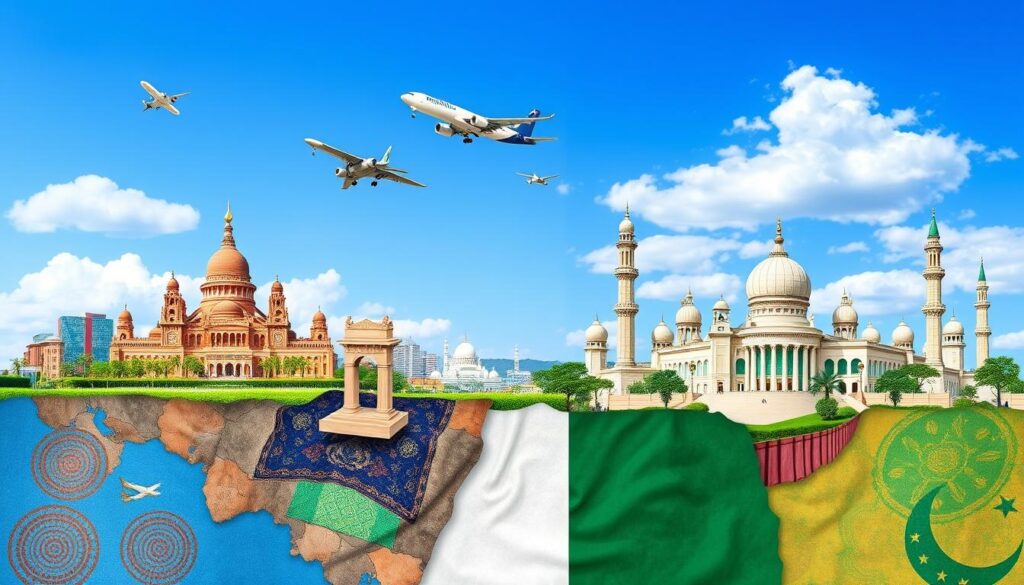Sri Lanka and Pakistan Discuss Enhancing Air Connectivity
Sri Lanka and Pakistan are exploring ways to boost air connectivity. Both nations are key members of SAARC. Improved aviation cooperation could significantly boost economic growth and bilateral ties.
The SAARC region has 1.936 billion people, 24.1% of the global population. Its combined GDP is $4.491 trillion. These factors make air connectivity crucial for the region’s development.
The seventh Round of Bilateral Political Consultations took place in Islamabad. It highlighted the need for stronger air travel agreements. Both countries see potential benefits in increased connectivity.

Sri Lanka’s tourism industry peaked in 2018 with 2.5 million visitors. These tourists spent US$5.6 billion. The country aims to attract more foreign investment in tourism.
Sri Lanka faced challenges from the COVID-19 pandemic and past civil war. Yet, it remains committed to developing its tourism sector. Enhancing air connectivity with Pakistan is part of this strategy.
Pakistan has been a top source of tourists for Sri Lanka. In 2018, 9,774 Pakistani tourists visited. The numbers rose to 10,744 in 2019. Even in 2020, 6,260 Pakistani tourists came to Sri Lanka.
Better aviation links could encourage more travel between the two nations. This would benefit both economies. It would also strengthen bilateral relations between Sri Lanka and Pakistan.
High-Level Pakistani Delegation Meets Sri Lankan Prime Minister
A top Pakistani business team met with Prime Minister Harini Amarasuriya this week. They discussed ways to boost economic ties between their countries. The focus was on improving air travel, tourism, and trade.
Prime Minister Amarasuriya praised the strong partnership between Sri Lanka and Pakistan. She noted the benefits of better air links. These could boost tourism and create new economic opportunities.
Exploring Possibilities of Strengthening Aviation Links
The Pakistani team stressed the need for better air connections. More flights and new routes could help business and personal travel. This fits with Sri Lanka’s recent agreements to boost tourism with other countries.
Potential Benefits for Sri Lanka’s Tourism Industry
Better air links could greatly help Sri Lanka’s tourism. Pakistan is a key source of visitors to Sri Lanka. Improved flights could bring more tourists to the country.
This comes at a crucial time for Sri Lanka’s tourism sector. The industry has faced recent challenges and is looking to recover.
The meeting set the stage for more teamwork in tourism and trade. Both countries aim to strengthen their relationship. Improved connections and trade are expected to help both nations grow.
Sri Lanka and Pakistan Discuss Enhancing Air Connectivity to Boost Tourism
Sri Lanka and Pakistan held their seventh Bilateral Political Consultations in Islamabad. Foreign Secretaries Aruni Wijewardane and Muhammad Syrus Sajjad Qazi co-chaired the meeting. They reviewed relations in economy, trade, defense, security, education, culture, and more.
Seventh Round of Bilateral Political Consultations in Islamabad
Both sides stressed the importance of high-level political exchanges. They agreed to tackle transnational organized crime, including drug trafficking. The talks highlighted potential for better air links between Colombo and Islamabad.
Pakistan is Sri Lanka’s second-largest SAARC trading partner after India. Improved air connectivity could boost trade under the 2005 free trade agreement.
Increasing Connectivity and Bilateral Trade for Economic Growth
Tourism is vital to Sri Lanka’s economy. Better air links could attract more Pakistani tourists to Sri Lanka’s diverse landscapes. It may also lead to more business exchanges and stronger economic ties.
Sri Lankan exports already have a significant share in Pakistan. Direct flights could further increase bilateral trade. This focus on air connectivity shows a vision for stronger economic cooperation.
Enhancing Tourism and People-to-People Contacts through Cultural, Religious, and Sports Links
The talks emphasized air connectivity’s role in boosting tourism and cultural exchanges. At the meeting’s end, Sri Lanka donated five eye corneas to Pakistan. This gesture shows the strong ties between the two nations.
Improved air links could further strengthen these connections. It would make travel easier for tourism, cultural events, and sports exchanges.





